
Article provides objective ways to support an idea using logic, data, and non-emotional appeal to persuade others.
- Subject:
- Career and Technical Education
- Material Type:
- Reading
- Reference Material
- Author:
- Rob Furman
- Date Added:
- 05/22/2018

Article provides objective ways to support an idea using logic, data, and non-emotional appeal to persuade others.
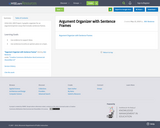
CESA #1EL OER Project: A graphic organizer for an argument/opinion essay that includes sentences frames.
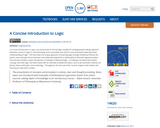
A Concise Introduction to Logic is an introduction to formal logic suitable for undergraduates taking a general education course in logic or critical thinking, and is accessible and useful to any interested in gaining a basic understanding of logic. This text takes the unique approach of teaching logic through intellectual history; the author uses examples from important and celebrated arguments in philosophy to illustrate logical principles. The text also includes a basic introduction to findings of advanced logic. As indicators of where the student could go next with logic, the book closes with an overview of advanced topics, such as the axiomatic method, set theory, Peano arithmetic, and modal logic. Throughout, the text uses brief, concise chapters that readers will find easy to read and to review.
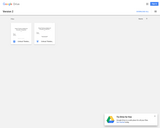
It is our hope that the successful student who completes a class using all or some of this text will have improved skills with application inside the discipline of philosophy, but also with application to work in other disciplines within academia. Our ultimate goal, however, is to help people develop techniques which support curiosity, open-mindedness, and an ability to collaborate successfully with others, across differences of experiences and background. Our dream is to help people “put their heads together.”
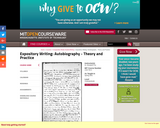
Subject focused on forms of exposition, including narration, critique, argument, and persuasion. Frequent writing assignments, regular revisions, and short oral presentations are required. Readings and specific writing assignments vary by section. See subject's URL for enhanced section descriptions. Emphasis is on developing students' ability to write clear and effective prose. Students can expect to write frequently, to give and receive response to work in progress, to improve their writing by revising, to read the work of accomplished writers, and to participate actively in class discussions and workshops. Focus: What can we believe when we read an autobiography? How do writers recall, select, shape, and present their lives to construct life stories? Readings that ground these questions include selections from Incidents in the Life of a Slave Girl by Linda Brent (pseudonym for Harriet Jacobs), "A Sketch of the Past" by Virginia Woolf, Notes of A Native Son by James Baldwin, "The Achievement of Desire" by Richard Rodriguez, The Woman Warrior by Maxine Hong Kingston, and "Our Secret" by Susan Griffin. Discussion, papers, and brief oral presentations will focus on the content of the life stories as well as the forms and techniques authors use to shape autobiography. We will identify masks and stances used to achieve various goals, sources and interrelationships of technical and thematic concerns, and "fictions" of autobiographical writing. Assignments will allow students to consider texts in terms of their implicit theories of autobiography, of theories we read, and of students' experiences; assignments also allow some autobiographical writing.
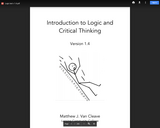
This is an introductory textbook in logic and critical thinking. The goal of the textbook is to provide the reader with a set of tools and skills that will enable them to identify and evaluate arguments. The book is intended for an introductory course that covers both formal and informal logic. As such, it is not a formal logic textbook, but is closer to what one would find marketed as a critical thinking textbook. Downloadable as a pdf file.
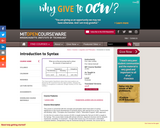
Introduction to theories of syntax underlying work currently being done within the lexical-functional and government-binding frameworks. Organized into three interrelated parts, each focused upon a particular area of concern: phrase structure; the lexicon; and principles and parameters. Grammatical rules and processes constitute a focus of attention throughout the course that serve to reveal both modular structure of grammar and interaction of grammatical components. This course is concerned with the concepts and principles which have been of central significance in the recent development of syntactic theory, with special focus on the "Government and Binding" (GB) / "Principles and Parameters" (P&P) / "Minimalist Program" (MP) approach. It is the first of a series of two courses (24.951 is taught during the Fall and 24.952 is taught in the Spring). This course deals mostly with phrase structure, argument structure and its syntactic expression, including "A-movement". Though other issues (e.g. wh-movement, antecedent-contained deletion, extraposition) may be mentioned during the semester, the course will not systematically investigate these topics in class until 24.952. The goal of the course is to understand why certain problems have been treated in certain ways. Thus, on many occasions a variety of approaches will be discussed, and the (recent) historical development of these approaches are emphasized.
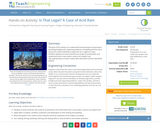
The goal of this activity is to understand how techniques of persuasion (including background, supporting evidence, storytelling and the call to action) are used to develop an argument for or against a topic. Students develop an environmental case study for presentation and understand how a case study is used as an analysis tool.

The Persuasion Map is an interactive graphic organizer that enables students to map out their arguments for a persuasive (opinion/argument) essay or debate. Students begin by determining their goal. They then identify three reasons to support their argument, and three facts or examples to support each reason. The map graphic in the upper right-hand corner allows students to move around the map, instead of having to work in a linear fashion. The finished map can be saved, e-mailed, or printed. The students can then take this map and transform it into a written persuasive piece.

This lesson allows students to explore the different sides associated with the issue of slavery. It can be used for either cross-content lessons between English and Social Studies, as part of an argument unit in English, or as part of a larger unit in Social Studies. The learning objectives for the lesson are that students are able to identify those who are for and against slavery, understand how people used the U.S. Constitution to support their reasons for/against slavery, and the economic argument for or against slavery.